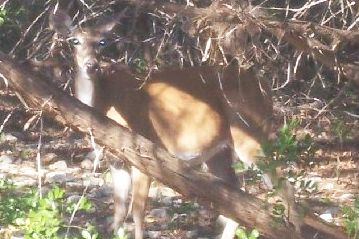 Besides the deer, “Murphy” came out in force when the Bexar Operators Group, W5BOG, assembled for their Field Day 2009 operation at Lost Maples State Park.
Besides the deer, “Murphy” came out in force when the Bexar Operators Group, W5BOG, assembled for their Field Day 2009 operation at Lost Maples State Park.
Despite “Murphys” best efforts, the Group would not bend whether it be from the 108 degree heat, no wind to drive the wind turbine, lack of park water and sewage due to a clogged septic system, the searing sun which blasted our digital camera after only a few shots nor the nearest ice machine being 5 miles outside the park entrance.
Arriving to the location on Friday (a full day before FD began – see reasons below), we sweltered while setting up two canopies, sleeping tent, antenna, gear, banks of solar panels, etc. We decided to stay after knowing that there would be no running water for showers and no toilets. Luckily we had brought plenty of water and fluids and our own port-a-potty with privacy tent.
While other Field Day operations used alternative power just to operate their rigs, we used 100% solar charged batteries for every electrical function including led lighting systems and 12 volt fans to cool off the operators, not to mention rigs and voice keyers. Our cooking was done using both propane and butane stoves. This was truly a 100% “green” operation.
The reason we came there a day earlier was to operate during a special emergency communications drill net using our systems for the Navy-Marine Corps MARS on Friday night. This was the first real test of operating from this location and making sure our selection of antennas and their orientation were correct.
The camping area in Lost Maples is nestled between two rather high hills which we feared might subdue our signals. By using an “inverted V” and placing it perpendicular, not parallel, to the hills proved a very effective means in “getting out” as verified by the great signal reports from all over Texas during the MARS emergency drill net on a frequency above 80 meters (exact frequency is confidential).
One other bad thing was due to the stress of setting up in the heat and sun, Krissy, KD5YTN, ended up with a bloody nose that first afternoon. It quickly subsided but it was a signal for us to take it a bit easier in the hot summer sun. It was so hot that we weren’t even bothered by insects!
Again, being absent of any wind, not at the ground level but at the height our turbine blades would be as determined by an leaf movement at the 30 foot tree height, we didn’t bother to erect our six-bladed wind turbine. It was one less thing to install in the heat. We didn’t need it to charge our seven deep-cycle marine batteries using wind energy as the glaring sun charged them via our six banks of solar panels. We isolated battery operation so any RF would not be induced in to the led lighting and fan power. (Since these were low power devices we used slightly smaller deep cycle batteries)
Our antennas were all “inverted Vs” with a simple pulley system to raise or lower the center easily and plug in extenders for band changes. All antennas were full length for the band in use. As stated in an earlier post, the antennas were constructed on the spot and all worked as planned. They also had both 2:1 baluns AND choke coils at the antenna center points.
The operating area was a well shaded picnic table area so there was no need to erect the third canopy as an operating area. This also helped cool us off whenever there was a minor “breeze” and it didn’t hold in the heat like a sided canopy might have. The two other canopies were used for a rest/storage area and cooking/dining facilities. Each evening brought a much needed respite from the hot days.
After a late wake up on Saturday and a lazy brunch, Field day began in earnest. Using a voice keyer and paper logs (my favorite) the chaos began. Operating first on 40 meters, then going up to 20 meters for a few hours, the contacts rolled in. In total during the course of Field Day we mustered slightly over 650 contacts operating as a 1Batt station.
Contacts were made by W2IK, with KD5YTN doing the logging and cooking, etc. We used our club call, W5BOG. We used the “camping out” on a frequency technique just as in a mad-scramble contest it pays to do the same. There were enough stations “hunting and pouncing” to make our techniques worthwhile.
In the evening, after sunset, we dropped to 80 meters until just before dawn when we jumped back to 40 meters in time to catch new stations due to the shift in propagation.
In any operating event or contest, the key is to work the bands that best suit your location and the propagation characteristics. The way to do this is to operate in smaller contests making note of how the bands change during the course of the event and applying the same theory to Field Day operations.
Krissy was again our head chef and did an excellent job at cooking and reminding us to drink enough water!
When the deadline of the event was reached, we quickly packed up the gear and sped a hasty retreat back home, glad that we had done what we set out to do, operate successfully from a completely unknown location using all solar power and proof that during an emergency we could do the same. This is yet another test of our club’s ability to operate under trying conditions.
Here are the few photos that survived the destruction of our Digital Camera…








